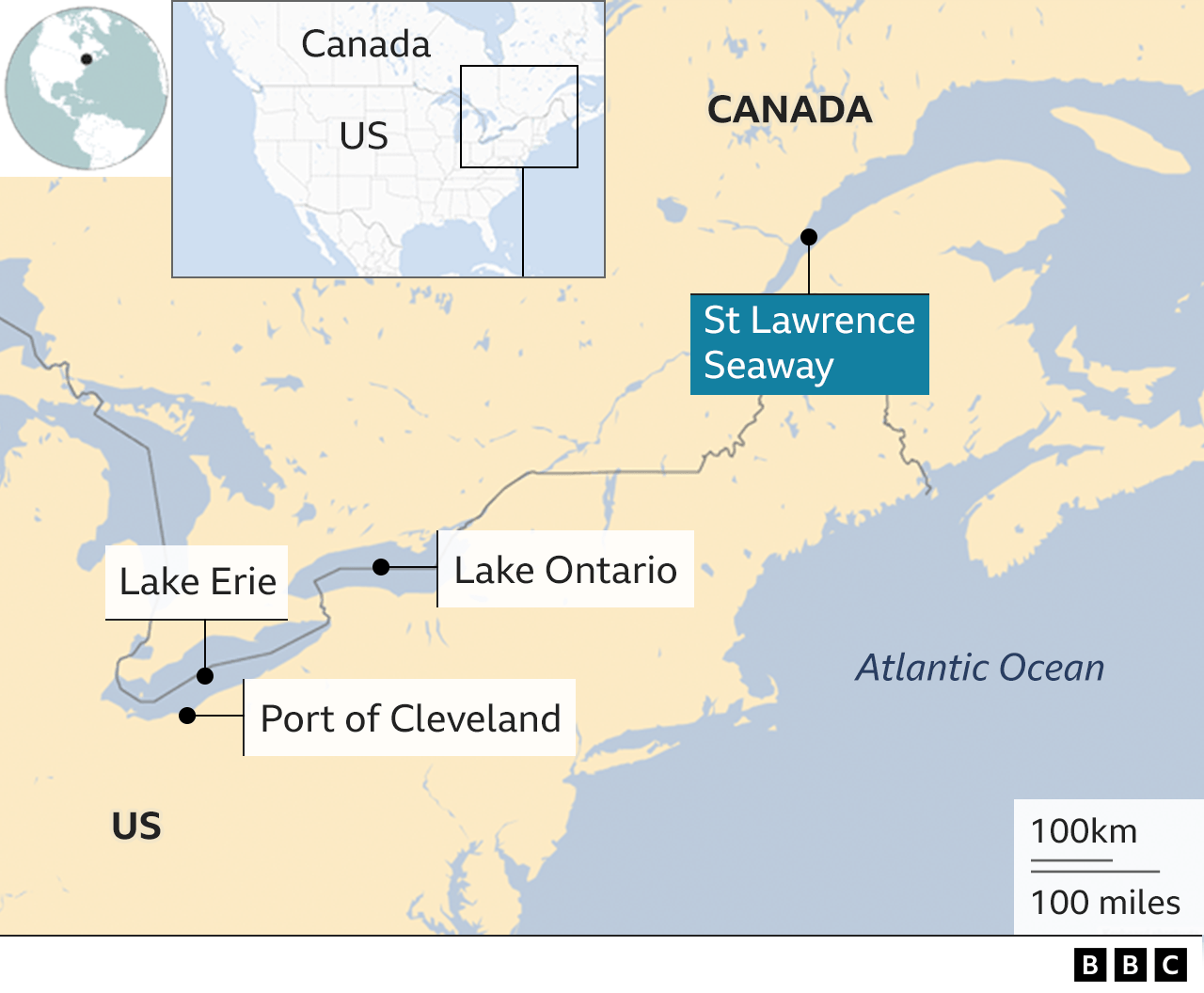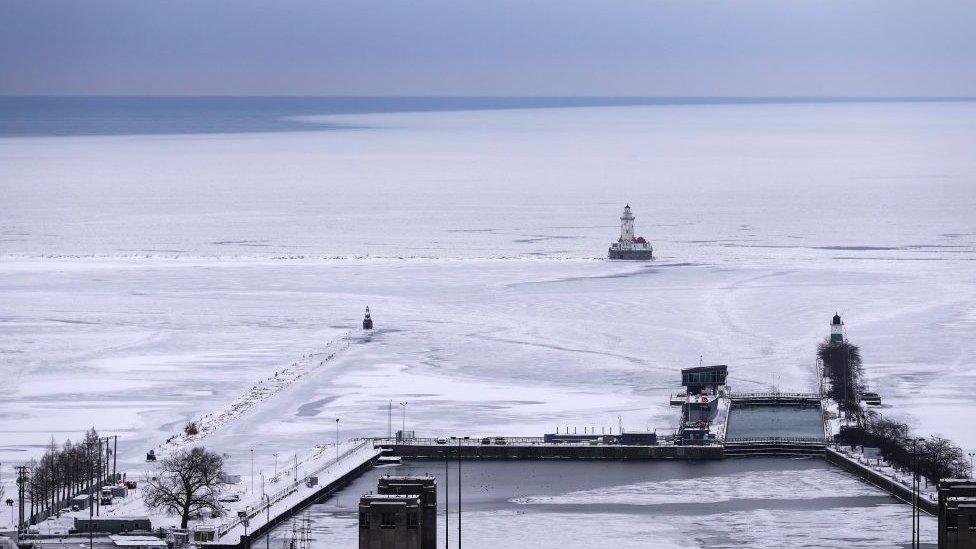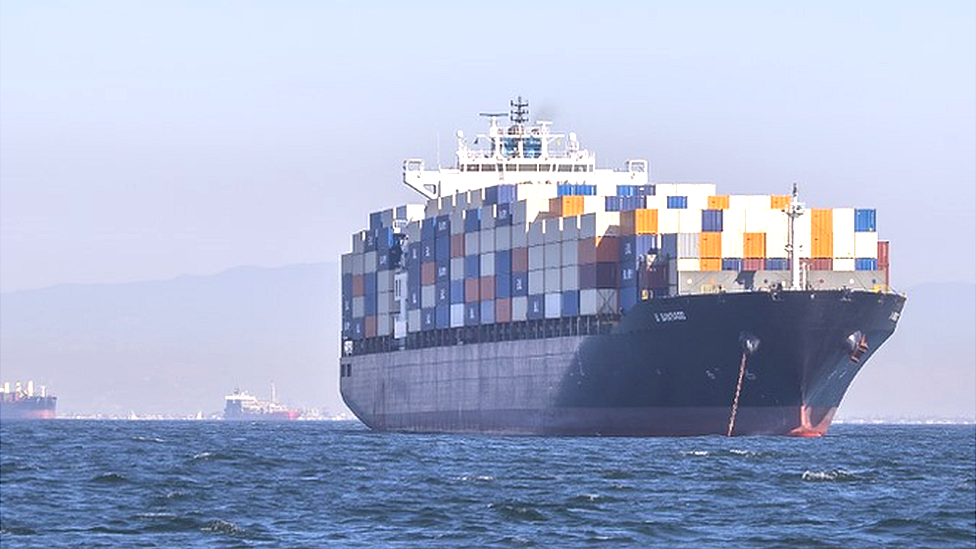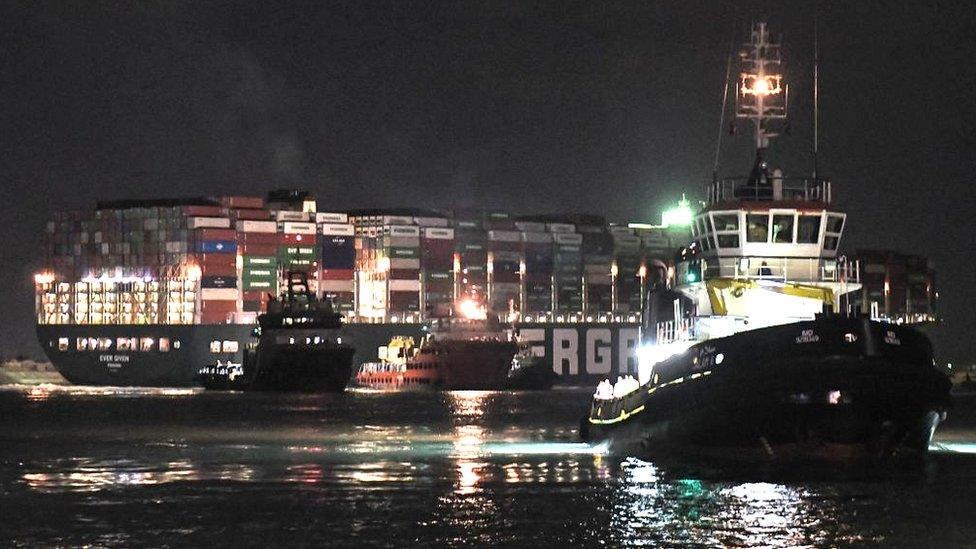Could the Great Lakes solve US shipping woes?
- Published

With coastal ports jammed, inland ports along the Great Lakes are stepping up to help the supply-chain
Lake Erie - one of five connected bodies of freshwater that make up the Great Lakes system along the US-Canada border - might not seem like a solution to America's supply chain issues.
But it might just be exactly that, writes Stephen Starr for the BBC.
Connected to the Atlantic Ocean via a system of canals and locks, the Port of Cleveland is one of several Great Lakes shipping centres experiencing a revival. Last year, the total tonnage handled by the port increased by 69% from 2020. April's tonnage numbers were double that of the same month in 2021.
"We're getting a lot more calls from people - shippers, cargo owners - that typically wouldn't want to consider using a smaller, inland port to move their cargo," said David Gutheil, chief commercial officer at the port.
With major ports along the US east and west coasts struggling with cargo backlogs due to knock-on effects from supply chain issues caused by everything from China's Covid lockdowns to Russia's war in Ukraine, shippers are looking to long-ignored ports as a way to get supplies into and out of America.
Global shipping companies were among the first to spot the Great Lakes' potential.

In August, a Dutch shipping company added an additional vessel to its Antwerp-Cleveland route to meet growing demand.
One ship even sailed all the way from Shanghai to Cleveland last November - a forty-day journey that bypassed major ports in southern California, Virginia and New Jersey - to avoid the backlogs plaguing those locations.
It's not just incoming international cargo companies that are looking to the Great Lakes ports to handle their wares. The Port of Cleveland is working with a Texas-based company trucking cargo from the Gulf of Mexico up to Lake Erie - a 1,000-mile journey - to get its products shipped out to Europe.
"They can't get vessel or container capacity down there (in Texas)," said Mr Gutheil.
While ports situated on the Atlantic and Pacific oceans dominate America's shipping industry today, that wasn't always the case. The Great Lakes ports once served as a crucial North American maritime highway for transporting agricultural and other bulk products such as iron ore, coal and limestone throughout the 1800s and 1900s.
The deregulation of the rail and especially the trucking industries in 1980, combined with the offshoring of manufacturing to Asia and elsewhere, however, saw the decline of the Great Lakes ports.
Located more than 2,200 miles from the Atlantic Ocean, the Port of Duluth-Superior was at its peak in the 1950s, when it handled about 70 million tonnes of goods such as iron ore and agricultural grain, making it the largest freshwater port in the world. By 2017, the amount of cargo it handled had fallen by more than half.
But today, as America's major coastal ports struggle to meet demand, the Great Lakes has the potential to expand capacity of the country's shipping industry. The Port of Cleveland, for example, is currently only moving about 10,000 containers a year but could potentially handle about 100,000 containers.
Six hundred and thirty miles northwest of Cleveland, the Port of Duluth-Superior - the largest in the Great Lakes - has expanded its facilities to include a customs station that now allows it to handle international cargo.
Its first overseas shipment of containers - 200 containers of bagged kidney beans destined for Italy, France, Germany and Hungary - set sail in late May.
And yet it's not all smooth sailing for the northern ports. Reports of a shortage of icebreaker ships hampered shipping activity last winter, as lakes froze.
Moreover, the 15 canal locks that allow ships to move between the Great Lakes and the Atlantic Ocean are not maintained and kept ice-free by their American and Canadian operators during the winter months.
That means that even if sections of southern Great Lakes such as Lake Erie and Lake Ontario don't freeze over in winter, access between the Great Lakes and the Atlantic wouldn't be possible.

The Great Lakes often freeze in the winter and disrupt the transport of ships
"One of the major hurdles to overcome is the seasonality issue; the Great Lakes are not open 12 months (of the year)," said Daniel Rust, an associate professor of transportation and logistics management at the University of Wisconsin-Superior.
"Supply chain managers want to always ship a certain way and to have a reliable supply chain for 12 months of the year".
Another challenge is that the locks can only facilitate vessels that are no wider than 78 feet (23.8 metres), which means that many ships cannot pass through. The Ever Given ship that blocked the Suez Canal for a week last year, for example, is 193 feet (59 metres) wide.
Industry experts say these issues could be overcome.
Establishing a feeder or shuttle service of smaller vessels would bridge that gap, say observers, and it's a move several Canadian ports have recently pursued. In June 2021, the Canadian maritime transport firm, Desgagnés, started a feeder service that ships close to 300 containers between Hamilton, Ontario, and the Port of Montreal.
With labour disputes possibly leading to backlogs in West Coast ports, and railroad congestion creating bottlenecks this summer, Americans may be facing more supply shortages in the months ahead.
All the while, people in the Midwest say they are standing by to help.
As Mr Gutheil put it: "If you have 10 or 20 ports … that handle as much as we do, then you start talking about meaningful change in the supply chain world".
Related topics
- Published16 October 2021

- Published29 March 2021

- Published9 July 2022

- Published4 June 2022

- Published1 February 2022
